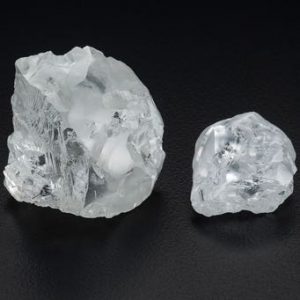Why Are Certain Diamonds So Beautiful? They’re Super-Deep!
By Rob Bates | June 09, 2021

"What do the 3,106 ct. Cullinan, the 1,109 ct. Lesedi La Rona, and Elizabeth Taylor’s Krupp have in common? In addition to being some of the most famous and valuable diamonds in the world, they’re all Type IIa, which means they have no measurable nitrogen or boron impurities and are therefore chemically pure.
Through his study of these diamonds at the GIA, research scientist Dr. Evan Smith and his colleagues have determined that most Type IIa diamonds—as well as just about every famous blue—are formed in what he calls the “super-deep,” the lower mantle of the Earth, more than 660 kilometers down. (Other diamonds form a mere 150 to 250 kilometers down.)
“These huge flawless D color nitrogen-free diamonds don’t form the same way as other diamonds,” Smith says. “They come from four times deeper in the Earth than other diamonds. They don’t form anywhere else.”
They even form differently. Type IIa rough is known to have a different shape than other rough.
Yet, while these diamonds are created way under the Earth, they have been found all over the planet, everywhere from Africa to North America, Smith says.
“Geographically, it’s hit and miss,” Smith says. “They don’t seem to follow the rules that normal diamonds follow.”
In a recent paper, Smith, his GIA colleague Dr. Wuyi Wang, and four other authors found that these diamonds form deep in the mantle in what Smith calls “a diamond factory.” (Ironically, diamonds grown in actual factories are also almost all Type IIa.) The study provides evidence that this factory is being supplied raw materials by a “conveyor belt” of subducted ocean rocks that have interacted with seawater. (Subduction is the process where the geographic plates sink down to the mantle. It also causes earthquakes and tsunamis.)
“The scientific importance is that this ‘conveyor belt’ is not just supplying ingredients to the Type IIa diamond factory—it represents the primary way in which any rocks, minerals, and elements, including water and carbon, are carried from the Earth’s surface down into its interior,” Smith says. “This mechanism of mixing of stuff down into the Earth’s interior is critical for our understanding of all kinds of large-scale events … such as the evolution of continents, oceans, atmosphere, volcanoes.”
Smith has been studying these diamonds for the last six years, and his research is perhaps a little more esoteric than the generally industry-focused work done at GIA. He has found that, as pure as these diamonds are, one can see unique inclusions with iron isotopes—particularly in the cast-off rough—that provide clues to what’s happening down way, way below. And, working out of GIA, Smith gets to examine a wide array of these stones.
Smith thinks his work could have practical aspects, including developing ways to locate more economical diamond mines. It could also enhance the gems’ mystique; after all, how many objects come from the super-deep?
Yet, most of his work now focuses on what he calls “fundamental science”: learning more about our planet.
No one has ever journeyed to the center of the Earth—except in books and movies. But Smith sees the inclusions in these diamonds as a possible window into a hidden world that we know very little about, but probably should, given we walk over it every day.
“[The diamonds] really are special in the information they contain. We are looking at where they come from, what kind of stories they can tell us. What can they tell us about what’s happening beneath our Earth?
“It’s not like the center of the Earth is a boring place,” he says. “There are some things happening down there.”
And by studying these diamonds, he hopes to have a better idea of what that is.
Correction: ... "
https://www.jckonline.com/editorial-art ... uper-deep/